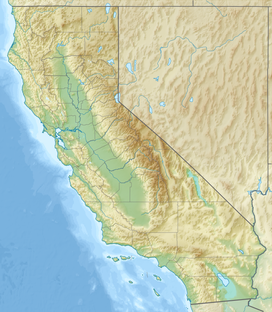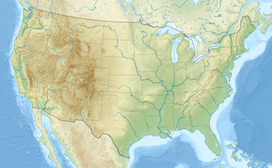geo.wikisort.org - Island
Morro Rock (Salinan: Le'samo; Chumash: Lisamu'; Spanish: El Morro)[4][5][6] is a volcanic plug in Morro Bay, California, on the Pacific Coast at the entrance to Morro Bay harbor. A causeway connects it with the shore, making it a tied island. The rock is protected as the Morro Rock State Preserve.[7]
| Morro Rock | |
|---|---|
 Morro Rock looking west | |
| Highest point | |
| Elevation | 581 ft (177 m) NAVD 88[1] |
| Coordinates | 35°22′10″N 120°52′03″W[1] |
| Geography | |
 Morro Rock  Morro Rock Morro Rock (the United States) | |
| Parent range | Santa Lucia Range |
| Topo map | USGS Morro Bay South |
| Geology | |
| Age of rock | c. 23 million years[2] |
| Mountain type | Volcanic plug |
| Volcanic arc/belt | Nine Sisters |
California Historical Landmark | |
| Designated | January 1, 1968 |
| Reference no. | 821[3] |


Geology
The 581-foot (177 m)[1] Morro Rock is one of 13 volcanic plugs (remnant necks of extinct volcanoes), lava domes, and sheetlike intrusions between Morro Bay on the north and Islay Hill on the south, all in San Luis Obispo County.[8]
It is composed mostly of dacite, an igneous, volcanic rock, and partially of petrified bird feces, which have compacted into the plug over the years. It is a groundmass of plagioclase, with amphibole (hornblende), biotite, pyroxene (augite), quartz, and glass; phenocrysts of plagioclase. Its silica dioxide (SiO2) content can range from 63 to 69 percent.
The dacite volcanic plugs, lava domes, intrusive sheets, and felsitic rhyolite-dacite between Morro Rock and Islay Hill are part of the Morro Rock-Islay Hill Complex of the Oligocene epoch (from 27 to 23 million years ago). The complex lies east of the San Gregorio-San Simeon-Hosgri fault (the SG-SS-H fault). This complex is one of three probable sources of the volcanic clasts within the sandstone and conglomerate of the Miguelito and Edna members of the Pismo Formation in the Point Sur area 145–160 km (90-100 mi) to the north and west of the SG-SS-H fault. Based on paleomagnetic signatures, the Morro Rock-Islay Hill Complex was rotated 40 to 50 degrees, perhaps during late Miocene or early Pliocene time.[9]
History
Tribal
The Salinan and Chumash tribes consider Morro Rock to be a sacred site. The Salinan name for Morro Rock is Le'samo and the Chumash name is Lisamu.
The Chumash had an important nearby prehistoric settlement at least as early as the Millingstone Horizon (6500-2000 B.C.E.), and the village was near the mouth of Morro Creek, at the current site of Morro Bay High School. The right of the Salinan people to climb Morro Rock for their biannual solstice ceremonies has been established, in which they celebrate the time in legend when a hawk and a raven destroyed a two-headed serpent-monster Taliyekatapelta as he wrapped his body around the base of the rock.[10] The established Salinan right to climb the rock has been in legal dispute by the local Chumash tribe, which claims that Morro Rock is Chumash, not Salinan, territory.[11] The Chumash also believe that the rock is so sacred that it should never be climbed. Because of its fragility, it is illegal for the general public to climb it.[12]
European sighting
Morro Rock was probably seen by Spanish maritime explorers as early as 1542 under Juan Rodríguez Cabrillo, but its current name was given during the first European land exploration of Alta California. The Spanish Portolá expedition came down Los Osos Valley and camped near today's Morro Bay on September 8, 1769. Franciscan missionary and expedition member Juan Crespí noted in his diary that "we saw a great rock in the form of a round morro".[13][14]
Quarry and historical landmark
The rock, which was quarried on and off from 1889 to 1969, provided material for the breakwater of Morro Bay and the improvements at Port San Luis Harbor.[15] In 1966, a state law was adopted that transferred title to the State of California. In February 1968, the San Luis Obispo County Historical Society and the City of Morro Bay succeeded in having Morro Rock declared California Historical Landmark number 821.[3][10]
Flora and fauna
Several types of birds nest on Morro Rock, including three cormorant species and two gull species.[16] It presently serves as a reserve for peregrine falcons, which are locally endangered and cause most of the laws that prohibit intervention with avian life.
Sea lions and sea otters can be seen regularly in the water around the rock.[17] Seals, however, are much more common in the nearby Morro Bay State Park, where they breed.
Other fauna include a wide selection of tide pool animals, like hermit crabs, small fish, starfish, sea cucumbers, mussels, bivalve mollusks, coral, and more.
On land few flora can survive the harsh, dry environment on the rock, but in the surrounding bay, kelp, sea grass, kelp forest plants, and tide pool plants can survive, and a few common grasses, mosses, lichens and weeds from the mainland take root on the rock itself.
Marine protected areas
Morro Bay State Marine Recreational Management Area and Morro Bay State Marine Reserve are protected areas offshore from Morro Bay. Like underwater parks, areas help conserve ocean wildlife and marine ecosystems.
Popular culture
- It was one of many local landmarks to be mentioned in "Weird Al" Yankovic's 1978 song "Take Me Down."
- In the 2020 video game Cyberpunk 2077, a radio station is featured called 107.3 Morro Rock Radio that is named after the Morro Rock. Further, the setting of Cyberpunk 2077 takes place in the fictional Night City which is built on top of Morro City.

See also
- List of beaches in California
- List of California state parks
References
- "Morro 2 reset". NGS Data Sheet. National Geodetic Survey, National Oceanic and Atmospheric Administration, United States Department of Commerce. Retrieved June 13, 2009.
- "Morro Rock State Preserve". California State Parks. Retrieved March 2, 2013.
- "Morro Rock". Office of Historic Preservation, California State Parks. Retrieved October 14, 2012.
- National Marine Sanctuaries - Proposed Designation of Chumash Heritage National Marine Sanctuary
- Environment America - We're thrilled that California’s central coast may get a new marine sanctuary
- City of Morro Bay - Morro Rock Beach
- "Morro Rock State Preserve". California State Parks. Retrieved January 11, 2010.
- The University of Auckland, ed. (2005). "Dacite".
- Hall, Clarence A Jr. (2007). Introduction to the Geology of Southern California and Its Native Plants. University of California Press. pp. Plate 17. ISBN 9780520933262. Retrieved January 31, 2017.
- Dillion, Angela H. (2008). "Preserving Nature and Culture at Morro Rock".
- PEMBERTON, PAT (December 8, 2014). "Chumash Fight State Over Access to Morro Rock". www.courthousenews.com. Retrieved August 23, 2022.
- Hogan, C. Michael (2008). A. Burnham (ed.). "Morro Creek ed. by A. Burnham".
- Bolton, Herbert E. (1927). Fray Juan Crespi: Missionary Explorer on the Pacific Coast, 1769-1774. HathiTrust Digital Library. pp. 182–184. Retrieved January 31, 2017.
- Gudde, Erwin G. (1969). California Place Names. Berkeley: University of California Press. p. 212.
- Herbaugh, Austin (August 23, 2022). "Pieces of Morro Rock to be brought back to original location". KSBY. Retrieved August 23, 2022.
- Joan Easton Lentz and Don DesJardin (2006) Introduction to Birds of the Southern California Coast, University of California Press, 316 pages ISBN 0-520-24321-8
- Fodor's (December 21, 2010). Fodor's Northern California 2011: With Napa, Sonoma, Yosemite, San Francisco & Lake Tahoe. Random House Digital, Inc. p. 80. ISBN 978-1-4000-0503-1. Retrieved December 25, 2011.
thumb
External links
- "Morro Rock". Geographic Names Information System. United States Geological Survey, United States Department of the Interior. Retrieved June 13, 2009.
- City of Morro Bay
- The Nine Sisters
На других языках
- [en] Morro Rock
[ru] Морро (скала)
Морро (англ. Morro Rock) — скала типа «вулканический купол» на территории города Морро-Бей[en], округ Сан-Луис-Обиспо, штат Калифорния, США. Одна из так называемых Девяти сестёр — группы холмов из девяти некков, — самая западная и самая известная из них[2].Другой контент может иметь иную лицензию. Перед использованием материалов сайта WikiSort.org внимательно изучите правила лицензирования конкретных элементов наполнения сайта.
WikiSort.org - проект по пересортировке и дополнению контента Википедии